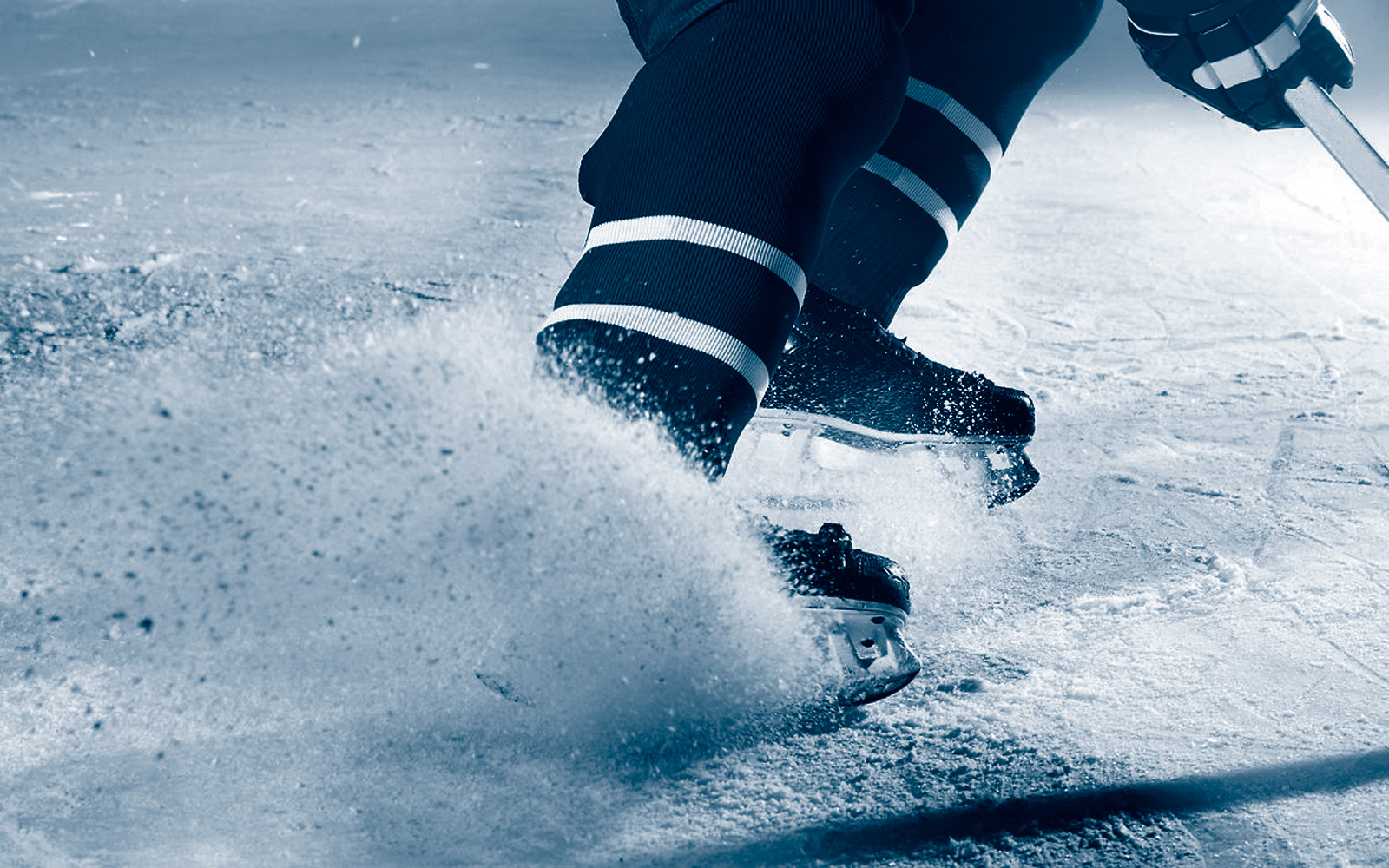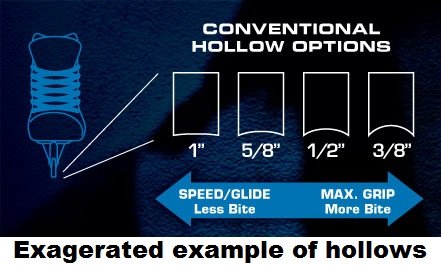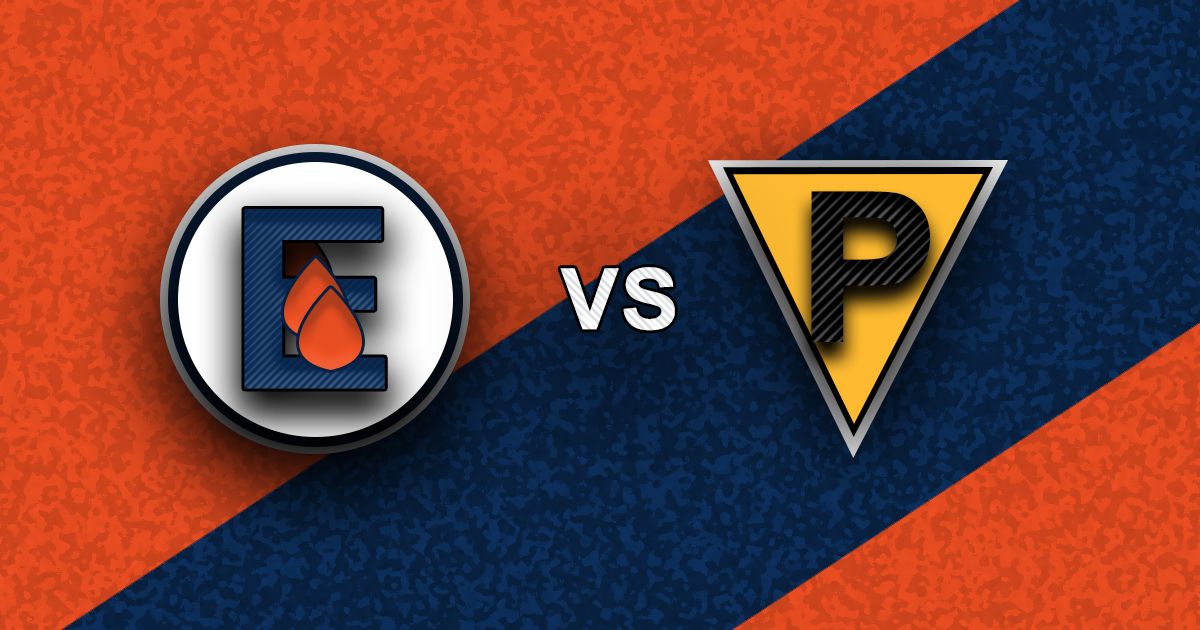
Every hockey player knows that you need to get your skates sharpened, but that doesn’t mean we really have any idea about it. How often should we get them sharpened? How sharp should we get them (what do all those fraction numbers mean?)? Should I be using re-edging tools like a Sweet Stick? Whether you’re a beginner hockey player just learning how to play, or a pro, hopefully this article can teach you something new.
How sharp to get your skates?
If you have ever felt or looked closely at the bottom of your hockey skates, you’ll notice that they aren’t so much a knife or blade as they are two sharp edges with the middle hollowed out. This hollow can be deeper or shallower depending on your preference, and logically enough, this is called your skates’ hollow (you may have heard a hockey shop ask you what you want your hollow to be before).
These hollows are measured in fractions of an inch, from 1″ to 3/8″ or 1/4″. Sharpening your skates involves passing them over a spinning stone with a rounded outer surface. This surface can be modified to have a very curved surface resembling a segment of a small circle, or it can be flatter, resembling part of a larger one. Altering the shape of the wheel’s surface will alter the size of the hollow it imparts on your skates. A larger radius will mean a flatter grinding wheel, and therefore a skate with less hollow cut away from its centre. The normal range for this is ⅜” to ¾”, although higher or lower hollows are occasionally seen. Typically, skate shops will do 1/2”, 5/8”, or 7/16” hollow as a default if they aren’t given any specific instructions. In the pictures here, you can see what these hollows look like when viewed up close.
We do this because each hollow will affect how the skate feels, and how it interacts with the ice. Deeper hollows will put more pressure on the edges of the blade and dig into the ice more. Shallow hollows will do the opposite. They distribute pressure more evenly throughout the blade, causing them to sit more on top of the ice.
How Hollows Affect Your Game
- Smaller radius of hollow (ie. ⅜”)
- Sharper skates
- Better suited to lighter players who dig in less to start with
- More energy lost into ice
- Extra effort required to skate
- Lower top speed
- More responsive turns and stops
- Quicker, more explosive acceleration
- Larger radius of hollow (ie. ⅝”)
- Duller skates
- Better suited to heavier players who have no trouble gripping the ice
- Less energy lost into ice
- More efficient skating
- Faster top speed
- Turns and stops will be less quick or sharp
- Acceleration is more limited
Other ways to customize your skate blades exist as well (eg. profiling the blade shape). However, these are beyond the scope of a typical beginner’s needs.
Other skate sharpening questions
- How often should I sharpen my skates?
- This is a very personal call. Some players will sharpen very frequently, such as every 2-3 hours of ice time, while others go for an entire season without sharpening. If you’re unsure of where to start, try getting them sharpened after 10 hours of ice time, and then adjust as you feel is necessary.
- It’s also worth noting that colder ice (especially the type found outdoors) is much harder, and will dull your skates very quickly. If you’re playing with your buddies on the outdoor rink, it’s probably a good idea to get a sharpening before your next game.
- What should I be doing to maintain my skates in between sharpenings?
- A honing stone is a great choice for maintaining your blades. Its job is to smooth out any burrs or nicks that can form on the sides of your blades, which can catch the ice and slow you down.
- Although tempting, re-edging tools (such as the sweet stick) cannot and should not replace regular sharpenings. They should be used for the occasional touch-up only, if you’re unable to get your skates sharpened before your big game. This is because they don’t hollow out the bottom of the blade the way an actual sharpening wheel would. Instead, they scrape away at the outsides of your blades, tapering them in to create a temporary edge.

- I’ve heard of a new sharpening style called Flat Bottom V (FBV). What is this, and how well does it work?
- FBV is similar to a traditional sharpening in the sense there’s still a grinding wheel which the skate blade is passed along. But instead of a round profile, the wheel is now flat in the centre and cut away further out, where the edges of the blade will be. This makes your skate blade’s cross-section flat in the middle and angled into the ice along the edges. It’s intended to give the user more glide without sacrificing bite as much as a traditional sharpening would. Everyone seems to have their own opinion on it – some users find it to be largely the same as a traditional hollow, while others find it greatly improves their game. I would encourage you to try it out and form your own opinions.
So the next time you go get your hockey skates sharpened, maybe try a new hollow depending on the criteria above and find what works best for you!



